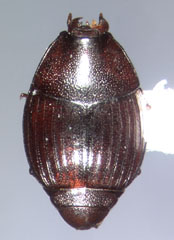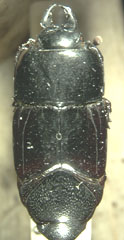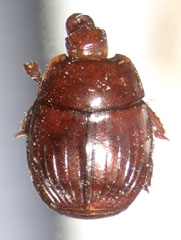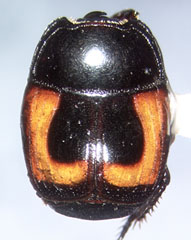Histerinae
Michael S. Caterino


This tree diagram shows the relationships between several groups of organisms.
The root of the current tree connects the organisms featured in this tree to their containing group and the rest of the Tree of Life. The basal branching point in the tree represents the ancestor of the other groups in the tree. This ancestor diversified over time into several descendent subgroups, which are represented as internal nodes and terminal taxa to the right.

You can click on the root to travel down the Tree of Life all the way to the root of all Life, and you can click on the names of descendent subgroups to travel up the Tree of Life all the way to individual species.
For more information on ToL tree formatting, please see Interpreting the Tree or Classification. To learn more about phylogenetic trees, please visit our Phylogenetic Biology pages.
close boxRelationships after Caterino & Vogler (2002)
Introduction
The Histerinae is very diverse in form and numbers of species, containing probably around one-half of all histerid species. The group includes some of the most commonly encountered species, particularly those associated with dung. However, habits of Histerinae are extremely diverse, including others associated with dead wood and other rotting vegetation, fungus, vertebrate nests, and the colonies of social insects. The inclusion of the exclusively myrmecophilous and termitophilous Hetaeriinae in this group has long been suspected, but has only recently been demonstrated conclusively (Caterino & Vogler, 2002).
Characteristics
Histerinae are very diverse in form. Body shapes range from oval and convex (most Histerini) to strongly cylindrical (some Exosternini and Platysomatini) or flattened (some Platysomatini and most Hololeptini). The most consistent characters across the subfamily include lack of labral setae and the presence of a well developed prosternal lobe, which usually extends laterally to shield the antennae from beneath. However, many exceptions, particularly in the more unusually shaped groups (Hetaeriinae, Hololeptini) are known.
Discussion of Phylogenetic Relationships
The relationships shown above result from the recent work of Caterino & Vogler (2002). However, their taxon sampling was insufficient to provide significant confidence for most of these branches. The sister group relationship of Histerini and Hetaeriinae, although one of the more surprising results of the analysis was, in fact, relatively well supported by 18S rDNA data. The monophyly of all of these taxa is still questionable. Until tribal limits can be confidently established, no trees at this level will be very meaningful.
Hetaeriinae and Chlamydopsinae (both largely myrmecophilous) have often been considered sister groups, and the two share many unusual characters. However, many of these characters may well be convergences related to myrmecophily (Slipinski & Mazur, 1999; Caterino & Vogler, 2002). Recent higher level studies instead place Hetaeriinae within Histerinae, although without a clear sister group therein. Exosternini presents many possible sister groups, and many Neotropical Exosternini are also myrmecophilous. However, 18S data suggest that Hetaeriinae are closer to Histerini (Caterino & Vogler, 2002). Additional sampling for 18S will likely answer this question, but the relevant taxa have proven difficult to obtain.
References
Caterino, M. S., and A. P. Vogler. 2002. The phylogeny of the Histeroidea. Cladistics 18(4):394-415.
Slipinski, S. A., and S. Mazur. 1999. Epuraeosoma, a new genus of Histerinae and phylogeny of the family Histeridae. Annales Zoologici (Warszawa) 49:209-230.
Information on the Internet
Masahiro Ohara’s Histeridae home page: HisterinaeTitle Illustrations

| Scientific Name | Exosternini |
|---|---|
| Location | Ecuador |
| Comments | undescribed genus |
| Specimen Condition | Dead Specimen |
| Image Use |
 This media file is licensed under the Creative Commons Attribution-ShareAlike License - Version 3.0. This media file is licensed under the Creative Commons Attribution-ShareAlike License - Version 3.0.
|
| Copyright |
© 2002

|
| Scientific Name | Hololepta |
|---|---|
| Location | Mexico |
| Specimen Condition | Dead Specimen |
| Image Use |
 This media file is licensed under the Creative Commons Attribution-ShareAlike License - Version 3.0. This media file is licensed under the Creative Commons Attribution-ShareAlike License - Version 3.0.
|
| Copyright |
© 2002

|
| Scientific Name | Tribalister marginellus |
|---|---|
| Location | USA |
| Specimen Condition | Dead Specimen |
| Image Use |
 This media file is licensed under the Creative Commons Attribution-ShareAlike License - Version 3.0. This media file is licensed under the Creative Commons Attribution-ShareAlike License - Version 3.0.
|
| Copyright |
© 2002

|
| Scientific Name | Hister lucanus |
|---|---|
| Location | southwestern North America |
| Specimen Condition | Dead Specimen |
| Image Use |
 This media file is licensed under the Creative Commons Attribution-ShareAlike License - Version 3.0. This media file is licensed under the Creative Commons Attribution-ShareAlike License - Version 3.0.
|
| Copyright |
© 2002

|
About This Page

Santa Barbara Museum of Natural History, Santa Barbara, California, USA
Page copyright © 2002
 Page: Tree of Life
Histerinae.
Authored by
Michael S. Caterino.
The TEXT of this page is licensed under the
Creative Commons Attribution License - Version 3.0. Note that images and other media
featured on this page are each governed by their own license, and they may or may not be available
for reuse. Click on an image or a media link to access the media data window, which provides the
relevant licensing information. For the general terms and conditions of ToL material reuse and
redistribution, please see the Tree of Life Copyright
Policies.
Page: Tree of Life
Histerinae.
Authored by
Michael S. Caterino.
The TEXT of this page is licensed under the
Creative Commons Attribution License - Version 3.0. Note that images and other media
featured on this page are each governed by their own license, and they may or may not be available
for reuse. Click on an image or a media link to access the media data window, which provides the
relevant licensing information. For the general terms and conditions of ToL material reuse and
redistribution, please see the Tree of Life Copyright
Policies.
- First online 07 March 2002
Citing this page:
Caterino, Michael S. 2002. Histerinae. Version 07 March 2002 (under construction). http://tolweb.org/Histerinae/9390/2002.03.07 in The Tree of Life Web Project, http://tolweb.org/













 Go to quick links
Go to quick search
Go to navigation for this section of the ToL site
Go to detailed links for the ToL site
Go to quick links
Go to quick search
Go to navigation for this section of the ToL site
Go to detailed links for the ToL site